What used to be popular jargon, “There’s an app for that”, has since evolved to the eCommerce space where now, “There’s a DTC brand for that”. In today’s market, there are hundreds of DTC brands who reportedly raised more than $3 billion as of 2019 . With these lofty investments, the pressure is on to turn profits quickly. Thus, brands are left challenged with realizing returns on customer acquisition costs (CAC), stagnant growth, and the burning of cash to fuel profitability.
Sell More, Lose More
Customer acquisition costs, or the dollars invested in marketing and advertising to gain new customers, is a challenge facing many brands. Not only do they have to spend strategically to get customers in the door, they have to then spend even more to keep them there. These companies, funded with similar expectations, invest in the same advertising channels, oftentimes targeting the same customers. In turn, driving up the demand and therefore costs of marketing online.
Take for example mattress disruptor, Casper. The company is now valued at a mere third of its once unicorn billion dollar valuation. As competition increased online with what is now over 100 DTC mattress brands, so did Casper’s marketing spend. They unveiled figures stating a loss of $67 million on $312 million in revenue in the first nine months of 2019. Expensive logistics associated with the shipping and returning of bulky mattresses was only stressed further with the costs of rising competition.
Another DTC player recently affected by reported losses is athleisure brand Outdoor Voices. CEO Ty Haney resigned early this year after the brand shed light on its $2 million continuous monthly losses. Though it’s unclear where this deficit stemmed from, Haney was criticized for her lapse in implementing processes in key areas such as inventory planning, among others.
Always Low Prices
Still, a departing CEO to some is less concerning than an online business abruptly shutting its virtual doors. This is exactly what happened to Brandless, an unbranded DTC consumables company that halted operations after just 2.5 years in the market. The company originally offered all organic private label products for just $3 - a feat they were able to take on due to their supply chain control. They cut out the middlemen in manufacturing and selling, or what they referred to as a “brand tax”, to simplify the overwhelming options and price variability in consumer packaged goods. But for Brandless, pricing as a differentiator wasn’t enough.
Price can be a tempting differentiator for online brands as the lack of store costs can provide a false sense of reassurance. But price is extremely easy to compete with and expensive to keep up with. Due to their $3 price point, which eventually evolved to multiples of $3 with an assortment expansion, they risked profitability over quality. Costs such as packaging, branding, and marketing also need to be considered beyond the cost of goods (COG). This is a challenge for brands starting out, but an easy play for bigger brands with economies of scale.
Brands like Costco and Amazon have superior supply chains and are able to offer their own “brandless” goods at affordable prices. Their lack of retail price limits allows them to offer valuable goods of all sizes, appealing to those who need more than what $3 can afford. When starting out, Brandless was determined to be a disruptor in the online space but quickly learned they would need the help of mega retailers to get their “brand” visibility.
Target was once viewed as a competitor for the young company but quickly became an ideal partner for growth. This didn’t pan out, and unsurprisingly, the mega retailer unveiled their own private label products resembling those of Brandless in 2018. If Brandless had a loyal customer base or new insightful data, the acquisition would have made more sense. But given the lack of following, product specialization, and cost limitations, Target was better off entering the market on their own.
A similar DTC brand, Public Goods, offers the same business model, though their value proposition is related to the ease of delivery of everyday products. No pricing thresholds means this brand has more runway to scale. And with $3 million in funding compared to Brandless’s $240 million, there is surely less pressure to turn around quick profits.
And Then There Was One
There is undeniably a cyclical challenge facing many DTC brands. The need for capital to scale a business is met with the pressure from investors to quickly gain profitability. These brands mainly have two options for success. They can either sell themselves to a larger conglomerate or they can keep growing until they go public. The former is the exact challenge razor brand Harry’s faced earlier this year. Similar to Dollar Shave Club which sold to Unilever 3 years ago, Harry’s was being eyed by Edgewell for a billion dollar acquisition. Unfortunately, due to FTC regulations, the deal fell through and the brand is still on its own, strategizing its next move.
So what should a DTC brand do? Some may look to Warby Parker, the original direct-to-consumer disruptor, for inspiration. The brand, which has been around since 2010 and profitable since 2018, limits its reliance on external funding. Instead, self funding as much as possible from it’s own successful strategies. It’s latest - a new line of contact lenses otherwise known as Scout. Evidently, the market has made a lot of progress in the last decade, and Scout now faces competition from several other DTC lens solutions. Though Warby Parker is seemingly in a better position to scale.
It All Comes Down To Scale
Whether it's challenges in growth or managing cash, the common setback in DTC players is an inability to scale on their own. From these brands, we can learn a few notable lessons:
- Maintain an agile supply chain. Flexibility and speed in design, manufacturing, and lead times can help you pivot on customer demand and category expansion. Always be attentive to what sets you apart from the competition and why someone would want to buy from you. As competition increases, this agility will allow you to go to market faster with an audience already in place.
- Invest intelligently in your inventory. Goods essentially work like stocks. If you invest appropriately, they will return you cash - some faster than others. Invest poorly and your cash is tied up in excess inventory, unable to be spent in growth driving initiatives. With the right amount of profit realized from the sale of your products, you can set yourself to be self funded, avoiding the dependence and pressures of outside capital.
- Price appropriately. It’s not enough to cover the cost of a good from a supplier. Ensure your MSRP accounts for additional costs such as returns, advertising, overhead, and of course, profit. A good rule of thumb is to price 5x higher than the cost of procuring an item.
.png)

.png)









.png)



%20hover.png)
.png)
hover.png)







Let us know what you think about this post
Put your comment below.